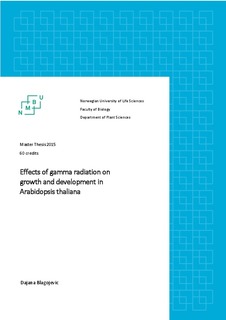| dc.description.abstract | Different types of abiotic stresses are known to have strong impact on morphological development of plants. Exposure of plants to ionizing radiation such as gamma radiation is potentially damaging, but effects may vary with species, radiation dose and life stage. Exposure of a biological system to gamma radiation may involve two types of effects within the cells, direct and indirect. Direct targets involve water, in which gamma radiation results in electron excitation or water radiolysis and further leads to chain reactions that produce secondary oxygen species (ROS). On the other hand, indirect effects of radiation affects the DNA helix, depending on the dose; it induces DNA breaks, which may lead to chromosomal and genomic abnormalities. In order to defend themselves, plants possess cell cycle checkpoints and systems repairing DNA damages.
In A. thaliana the transcription factor Long Hypocotyl 5 (HY5), which is crucial in photomorphogenic development and formation of flavonoids acting as antioxidants, plays a major role in light and UV signaling. The ubiquitin ligase Constitutive Photomorphogenesis 1 (COP1) is essential in controlling HY5 by degradation of HY5 in darkness in contrast to in light. In A. thaliana HY5 was shown to play a crucial role in stem elongation and flavonoid biosynthesis under UV-exposure and lowered temperature.
The purpose of this study was to investigate after effects of gamma radiation at the molecular, morpho-structural and physiological levels in the A. thaliana wild type (WT) Ler and the hy5 mutant treated with different gamma doses ranging from 21.6 to 90.7 Gy. This included evaluation of expression of the RAD51 RECOMBINASE (RAD51) and TRANSAPARENT TESTA (TT4) gene, which play roles in DNA double strand break repair and biosynthesis of flavonoids, respectively, in plants cells. In addition, High performance liquid chromatography (HPLC) analysis was also performed in order to study production of phenolic acids and flavonoids. Investigations on the physiological level included recording of: rosette leaf formation, leaf area, stem elongation and time to visible flower buds. As late as 51 days after the gamma exposure, relative transcript levels of RAD51 were increased in the WT under the highest gamma exposure doses 90.7 Gy and 72.2 Gy, compared to the unradiated control, indicating that the up-regulation of RAD51 by gamma radiation is quite persistent, while the TT4 gene did not show any significant differences between treatments. The total level of flavonoids in the WT displayed significant differences between the highest gamma dose (90.7 Gy) compared to the control, while the total level of phenolic acids did not differ between the dose s. At the physiological level, only small differences were observed between different gamma treatments compared to control, in both genotypes. | nb_NO |

